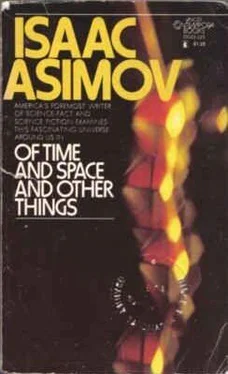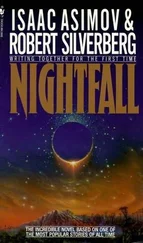Isaac Asimov - Of Time and Space and Other Things
Здесь есть возможность читать онлайн «Isaac Asimov - Of Time and Space and Other Things» весь текст электронной книги совершенно бесплатно (целиком полную версию без сокращений). В некоторых случаях можно слушать аудио, скачать через торрент в формате fb2 и присутствует краткое содержание. Год выпуска: 1972, ISBN: 1972, Издательство: Lancer Books, Жанр: Прочая научная литература, на английском языке. Описание произведения, (предисловие) а так же отзывы посетителей доступны на портале библиотеки ЛибКат.
- Название:Of Time and Space and Other Things
- Автор:
- Издательство:Lancer Books
- Жанр:
- Год:1972
- ISBN:ISBN: 0-447-33023-3
- Рейтинг книги:4 / 5. Голосов: 1
-
Избранное:Добавить в избранное
- Отзывы:
-
Ваша оценка:
- 80
- 1
- 2
- 3
- 4
- 5
Of Time and Space and Other Things: краткое содержание, описание и аннотация
Предлагаем к чтению аннотацию, описание, краткое содержание или предисловие (зависит от того, что написал сам автор книги «Of Time and Space and Other Things»). Если вы не нашли необходимую информацию о книге — напишите в комментариях, мы постараемся отыскать её.
Of Time and Space and Other Things — читать онлайн бесплатно полную книгу (весь текст) целиком
Ниже представлен текст книги, разбитый по страницам. Система сохранения места последней прочитанной страницы, позволяет с удобством читать онлайн бесплатно книгу «Of Time and Space and Other Things», без необходимости каждый раз заново искать на чём Вы остановились. Поставьте закладку, и сможете в любой момент перейти на страницу, на которой закончили чтение.
Интервал:
Закладка:
In the case I've just cited, the acceleration is 1 centi meter per secondevery second, since each successive sec ond it is going I centimeter per second faster. You might say that the acceleration is I emlsec per second. Since we are letting the word "per" be represented by a fraction mark, this may be represented as 1 cm/sec/sec.
As I said before, we can treat the units by the same manipulations used for algebraic symbols. An expression like alblb is equivalent to alb b, which is in turn equiva lent to alb x Ilb, which is in turn equivalent to alb2. By the same reasoning, I cm/sec/sec is equivalent to 1 cm/ seC2 and it is CM/SCC2 that is therefore the unit of accelera tion.
A "force" is defined, in Newtonian physics, as some thing that will bring about an acceleration. By Newton's First Law of Motion any object in motion, left to itself, will travel at constant speed in a constant direction forever.
A speed in a particular direction is referred to as a t'veloc ity," so we might, more simply, say that an object in mo tion, left to itself, will travel at constant velocity forever.
This velocity may well be zero, so that Newton's First'Law also says that an object at rest, left to itself, will remain at rest forever.
As soon as a force, which may be gravitational, electro magnetic, mechanical, or anything, is applied, however, the velocity is changed. This means that its speed of travel or its direction of travel or both is changed.
The quantity of force applied to an object is measured by the amount of acceleration induced, and also by the mass of the object, since the force applied to a massive ob ject produces less acceleration than the same force applied to a light object. (If you want to check this for yourself, kick a beach ball with all your might and watch it accel erate from rest to a good speed in a very short time. Next kick a cannon ball with all your might and observe-while hopping in agony-what an unimpressive acceleration you have imparted to it.)
to assure yourself, first, of a supply of nine hundred quin tiflion ergs.
This sounds impressive. Nine hundred quintillion ergs, wow!
But then, if you are cautious, you might stop and think:
An erg is an unfamiliar unit. How large is it anyway?
After all, in Al Capp's Lower Slobbovia, the sum of a billion slobniks sounds like a lot-until you find that the rate of exchange is ten billion slobniks to the dollar.
So-How large is an erg?
Well, it isn't large. As a matter of fact, it is quite a small unit. It is forced on physicists by the lo 'c of the gram-cen 91 timeter-second system of units, but it ends in being so small a unit as to be scarcely useful. For instance, consider the task of lifting a pound weight one foot against gravity.
That's not difficult and not much energy is expended. You could probably lift a hundred pounds one foot without completely incapacitating yourself. A professional strong man could do the same for a thousand pounds.
Nevertheless, the energy expended in lifting one pound one foot is equal to 13,558,200 ergs. Obviously, if any trifling bit of work is going to involve ergs in the tens of millions, we need other and larger units to keep the nu merical values conveniently low.
For instance, there is an energy unit called a joule, which is equal to 10,000,000 ergs.
This unit is derived from the name of the British physi cist James Prescott Joule, who inherited wealth and a brew ery but spent his time in research. From 1840 to 18 9 e ran a series of meticulous experiments which demonstrated conclusively the quantitative interconversion of heat and work and brought physics an understanding of the law of conservation of energy. However, it was the erman sci entist Hermann Ludwig Ferdinand von Helmholtz who first put the law into actual words in a paper presented in 1847, so that he consequently gets formal credit for -,the discov ery.
(The word "joule," by the way, is most commonly pro nounced "jowl," although Joule himself probably pro 167 nounced his name "jool." In any case, I have heard over precise people pronounce the word "zhool" under the im pression that it is a French word, which it isn't. These are the same people who pronounce "centigrade" and "centri fuge" with a strong nasal twang as "sontigrade" and "son trifugp,," under the impression that these, too, are French words. Actually, they are from the Latin and no pseudo French pronunciation is required. There is some justifica tion for pronouncing "centimeter" as "sontimeter," since that'is a French word to begin with, but in that case one should either stick to English or go French all the way and pronounce it "sontimettre," with a light accent on the third syllable.)
Anyway, notice the usefulness of the joule in everyday affairs. Lifting a pound mass a distance of one foot against gravity requires energy to the amount, roughly, of 1.36 joules-a nice, convenient figure.
Meanwhile, physicists who were studying heat had in vented a unit that would be convenient for their purposes.
This was the "calorie" (from the Latin word color meaning "heat"). It can be abbreviated as cal. A calorie is the amount of heat required to raise the temperature of I gram of water from 14.5' C. to 15.5' C. (The amount of heat necessary to raise a gram of water one Celsius degree varies slightly for different temperatures, which is why one must carefully specify the 14.5 to 15.5 business.)
Once it was demonstrated that all other forms of energy and all forms of work can be quantitatively converted to heat, it could be seen that any unit that was suitable for heat would be suitable for any other kind of energy or work.
By actual measurement it was found (by Joule) that 4.185 joules of energy or work could be converted into pre cisely I calorie of heat. Therefore, we can say that I cal equals 4.185 joules equals 41,850,000 ergs.
Althouo the calorie, as defined above, is suitable for physicists, it is a little too small for chemists. Chemical re actions usually release or absorb heat in quantities that, under the conventions used for chemical calculations, re sult in numbers that are too large..For instance, I gram of ,carbohydrate burned to carbon dioxide and water (either in a furnace or the human body, it doesn't matter) liberates roughly 4000 calories. A gram of fat would, on burning, liberate roughly 9000 calories. Then again, a human being, doing the kind of work I do, would use up about 2,500,000 calories per day.
The figures would be more convenient if a larger unit were used, and for that purpose a larger calorie was in vented, one that would represent the amount of heat re quired to raise the temperature of 1000 grams (1 kilo gram) of water from 14.50 C. to 15.5' C. You see, I sup pose, that this larger calorie is a thousand times as great as the smaller one. However, because both units'are called calorie," no end of confusion has resulted.
Sometimes the two have been distinguished as "small calorie" and "large calorie"; or "gram-calorie" and "kilo gram-calorie"; or even "calorie" and "Calorie." (The last alternative is a particularly stupid one, since' in speech and scientists must occasionally speak-there is no way of distinguishing a C and a c by pronunciation alone.)
My idea of the most sensible way of handling the matter is this: In the metric system, a kilogram equals 1000 grams; a kilometer equals 1000 meters, and so on. Let's call the large calorie a kilocalorie (abbreviated kcal) and set it equal to 1000 calories.
In summary, then, we can say that 1 kcal equals 1000 cal or 4185 joules or 41,850,000,000 ergs.
Another type of energy unit arose in a roundabout way, via the concept of "power." Power is the rate at which work is done. A machine might lift a ton of mass one foot against gravity in one minute or in one hour. In each case the energy consumed in the process is the same, but it takes a more powerful heave to lift that ton in one minute than in one hour.
Читать дальшеИнтервал:
Закладка:
Похожие книги на «Of Time and Space and Other Things»
Представляем Вашему вниманию похожие книги на «Of Time and Space and Other Things» списком для выбора. Мы отобрали схожую по названию и смыслу литературу в надежде предоставить читателям больше вариантов отыскать новые, интересные, ещё непрочитанные произведения.
Обсуждение, отзывы о книге «Of Time and Space and Other Things» и просто собственные мнения читателей. Оставьте ваши комментарии, напишите, что Вы думаете о произведении, его смысле или главных героях. Укажите что конкретно понравилось, а что нет, и почему Вы так считаете.












